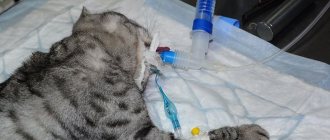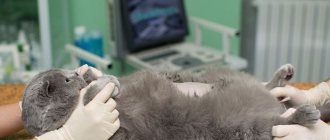7898Pavel
For many cat owners, pregnancy of their pet is a real problem. What should you do if your cat has become pregnant? Is it possible to sterilize a pregnant cat?
Sterilization during pregnancy can be dangerous to the health of the animal.
When deciding to sterilize a pregnant cat, you take a great risk, because this poses a considerable danger to the cat’s life. It will be much better if you allow her to carry and give birth to kittens. During surgery, the veterinarian must remove only the ovaries, but if she is already pregnant, the uterus will have to be opened and the fetuses removed or the uterus removed entirely.
The sterilization operation itself is very simple, but termination of pregnancy much more often leads to complications :
- inflammation due to infection;
- bleeding and severe blood loss;
- stress and hormonal disorders.
© shutterstock
When is the best time to sterilize a pregnant cat?
If you suspect your pet is pregnant, it is best to contact your veterinarian as soon as possible. First, an examination is performed to confirm pregnancy. If the cat is healthy, it is better to let her give birth. But sometimes an operation to sterilize pregnant cats is carried out at the insistence of the owners. It is much safer to sterilize in the early stages . And in no case should you decide to operate for more than six weeks.
It is better to choose an experienced veterinarian who has spayed pregnant cats. This is a complex procedure, and the risk will be unnecessary.
© shutterstock
Mr. Cat Explains: Principles of Operation
Removing embryos from the uterus during the sterilization process is quite difficult. This is due to some distinctive features of the structure of the cat’s reproductive system. Due to the significant extent of the bicornuate uterus, during pregnancy it can accommodate several fetuses at once.
Even a highly qualified veterinarian is not able to remove future kittens from the uterus without damaging its walls. For this reason, sterilization is performed, in which the doctor makes an incision in the abdominal area to remove and eliminate the ovaries and uterus with developing embryos. This surgical intervention is called “extirpation of the pregnant uterus”; it is more risky compared to simple sterilization.
Features of the procedure
The sterilization procedure consists of the following steps:
- preoperative examination - to determine whether it is safe to perform
- surgery for a pregnant cat;
- preparation for the administration of anesthesia - dose calculation, choice of drugs;
- operation;
- recovery from anesthesia;
- postoperative recovery.
The examination is an important stage during which the veterinarian is obliged to find out the general health of the cat. If there are symptoms such as poor appetite, hair loss and others, sterilization of the pregnant cat will have to be cancelled.
Sterilization in cats is characterized by the following feature: before administering the drug for anesthesia, the animal is given drugs to maintain the functioning of the cardiovascular system. This is necessary to prepare your pet’s body before the strong effects of anesthesia on its nervous system.
Neutering a pregnant cat is a more complex operation than regular spaying. It is more dangerous because the cat’s uterus is longer than a human’s, and during pregnancy it is pierced by many blood vessels. Because of this, the risk of severe blood loss and even death of the animal increases.
© shutterstock
Why is surgery dangerous during pregnancy?
During pregnancy, surgery poses a serious risk to the health and life of the cat. The danger is as follows:
- Loss of a significant amount of blood. Blood loss during surgery is inevitable in principle, and if there are embryos in the uterus, they increase many times over.
- A large number of postoperative sutures, which will greatly disturb the cat.
- A long postoperative recovery, which may end unfavorably for the pet’s health. Hormonal and physiological stress doubles during pregnancy, which can negatively affect your well-being.
Important! In order for the procedure to go as smoothly as possible and with fewer consequences, the owner needs to prepare in advance for his cat’s surgery: find out all the details of the procedure, weigh the pros and cons, find a good clinic and first-class specialists. Only in this case can you count on a favorable outcome of the operation with fewer risks to the cat’s health.
Possible consequences
Consequences after surgery to remove reproductive organs in a pregnant cat are not uncommon. You should contact a veterinary clinic if your pet exhibits the following signs:
- refusal to eat for more than 3 days after surgery;
- change in body temperature: increase to 39.5 °C after surgery on days 3-5;
- severe swelling at the location of the suture;
- the appearance of purulent discharge in the area of the wound surface and the appearance of an unpleasant odor.
The animal's apathetic state, lethargy and severe drowsiness should also be a cause for concern for the owner.
Indications for termination of pregnancy and sterilization
Is it possible to spay a cat during heat?
Extirpation of the uterus and appendages during pregnancy of a cat is prescribed extremely rarely and only if there are serious reasons for this. As a rule, this is the development of pyometra or a malignant tumor diagnosed in the uterine area. Whether a cat can become pregnant after sterilization depends only on what kind of procedure was performed. If reproductive organs were removed during surgery, the possibility of further fertilization and pregnancy is excluded.
Pathological changes in the uterus with fetuses
After sterilization or castration, which is more appropriate for such manipulation, the cat’s body will continue to produce female hormones estrogens for more than 40 days. After castration, hormonal levels decrease, and the cat itself becomes affectionate and flexible.
Sterilization of a cat during pregnancy can be carried out only in extreme cases when clinically indicated:
- disruption of fetal development in the womb;
- disease of the mother cat, provoked by the onset of pregnancy;
- advanced age of the pet and the presence of chronic diseases.
In some clinical cases, hysterectomy is indicated even in later stages. This will avoid the death of the cat. It is recommended to sterilize a cat during pregnancy with a short interval between previous births, as well as during pregnancy and lactation.
For your information! Surgical intervention to remove the reproductive organs is indicated when a kitten becomes pregnant under 4 months of age.
An indication for manipulation is also the risk of giving birth to kittens with serious congenital defects.
Pyometra in a cat
This is interesting: How many kittens can a cat give birth to?
Specifics of surgical intervention
A pregnant cat can be sterilized early or late in pregnancy. The specifics of the operation remain unchanged - the veterinarian removes the uterus and ovaries. However, the longer the period, the more difficult the surgical intervention will be. In such a situation, not simple sterilization is performed, but ovariohysterectomy or castration.
The process involves removing the ovaries and uterus at the same time. Experts give preference to ridding the animal of the entire reproductive system, since tumors or other diseases may begin to develop due to the abandonment of the uterus.
Any surgical intervention is performed under general anesthesia in a veterinary hospital. Conventional sterilization is carried out using a seamless method, the final incision in such a situation is approximately 1 cm in length, but this is not suitable for a pet in this position. She will need long-term rehabilitation - the scar takes a long time to heal - and doctors will have to worry about possible bleeding. Babies, even in later stages, usually die.
Sterilizing a cat during pregnancy is more dangerous than undergoing simple surgery. At a later date, the likelihood of negative consequences increases.
As a result, veterinarians advise operating on the pet before the pregnancy reaches one month.
Under the influence of developing embryos, the uterus expands and they require more blood supply. Therefore, during surgery, an increase in blood loss is observed. Due to the increase in size of the uterus, the postoperative scar is very large.
In addition, at a later stage the body prepares for feeding kittens, this contributes to the occurrence of complications that will have to be encountered during the operation. In addition, the development of hormonal stress is observed. Because of these factors, the risk of developing negative consequences increases, namely, bleeding and inflammation in the scar area.
Also read articles about blood and other discharge in a pregnant cat.
Sterilization of cats as a manifestation of responsible animal husbandry
Sterilization of a cat in any form is a manifestation of responsible animal ownership.
Cats are capable of reproducing very quickly and productively. If the owners do not breed purebred animals and the cat’s pregnancy makes you wonder what to do with newborn kittens, you should cast aside all doubts and sterilize it. In this case, a number of problems can be solved:
- A sterilized cat will no longer bother the owner with its behavior related to the search for a partner.
- The owners of a sterilized cat will make their contribution to control the birth rate and the number of homeless animals.
- Domestic cats acquire infectious diseases from contact with stray cats. By controlling birth rates, cat owners help reduce the number of homeless animals and reduce the risk of infection in their pets.
Possible complications
The owner of the animal is often afraid of complications that may arise as a result of surgery. This is fine. However, if there are medical conditions, surgery must still be performed. Otherwise, the cat may die.
Veterinarians list the following possible complications after extirpation of the uterus with fetuses:
- Behavioral problems. At the subconscious level, the cat understands that it is pregnant. After the removal of the internal genital organs along with the embryos, she experiences stress, which even leads to depression.
- Sepsis. Blood poisoning is possible if there were dead fetuses in the uterus. Their breakdown products provoke acute inflammation.
- Intra-abdominal bleeding. If during an operation the surgeon accidentally damages the uterus, the cat may bleed to death in a matter of minutes and it will be extremely difficult to help.
- Peritonitis. This is an infectious inflammation of the peritoneum that can lead to death. It develops when sanitary and hygienic standards are not observed during surgery, and pathogenic microbes and bacteria enter the abdominal cavity.
- Incorrectly calculated dose of anesthesia. It is difficult for a pregnant cat to choose an anesthetic drug. If the dose is calculated incorrectly, the animal runs the risk of waking up prematurely or not recovering from anesthesia at the end of the operation.
- Inflammation of the sutures. During extirpation, a long incision is made and it heals slowly. During the rehabilitation period, it may become infected. Against this background, inflammation appears.
Sometimes females after such operations develop hormonal disorders and aspiration pneumonia.
The decision about whether a cat can be sterilized during pregnancy is made by the doctor. After castration or sterilization, it is recommended to leave the pet for some time in a veterinary clinic under the supervision of a doctor.
Features of caring for an operated animal
Castration while carrying kittens comes with a lot of risks. To prevent negative consequences, the cat must be properly cared for in the postoperative period.
Care includes:
- putting on a blanket or bandage;
- regular change of dressings;
- treating seams with peroxide or brilliant green;
- examination and careful palpation of the abdomen;
- feeding with medicinal canned food;
- ensuring physical and psychological peace;
- arrangement of a soft sleeping place at floor level.
The health of the pet depends on the professionalism of the veterinary surgeon and the care of the owner. After experiencing stress, a cat may behave distantly for some time. This will pass. However, if more dangerous symptoms occur (fever, refusal to eat, lethargy), you should consult a doctor.
Sterilizing a pet means taking care of it
Sterilizing a cat in any condition means responsibly keeping your pet.
Cats are characterized by rapid and fruitful reproduction. In the case where the owner does not breed purebred kittens, it is necessary, casting aside doubts, to carry out sterilization.
A domestic cat can acquire an infectious disease through contact with stray animals. Thanks to birth control, the number of stray cats is reduced and the risk of infection of a pet is reduced.
1111
Care and care after surgery
Animals sterilized during pregnancy require special care afterward to prevent possible complications. After rehabilitation, the pet, as a rule, becomes calmer and more affectionate, and the aggressiveness that appeared due to hormonal changes during sexual arousal disappears.
Immediately after surgery, the cat should be placed in a warm, dark, and soft place until the anesthesia wears off.
Recovery is quite painful; therefore, while the animal is recovering, you should not contact it. This is especially true for disturbances from children and other pets.
During the rehabilitation process, the owner must take care of the condition of the scar, make sure that it does not get wet or fester, that it is dry and clean. Typically, a postoperative scar heals in 7-10 days.
In addition, during the recovery process the cat is prescribed antibiotics and vitamin preparations. You should also wipe your pet's eyes with contact lens solution so that they open normally after using anesthesia.
Special clothing can be used so that the post-operative suture heals faster and the scarring process proceeds as expected.
We recommend reading the article about food for sterilized cats.
Veterinarian advice
Cat owners decide to sterilize their cats so that their pet does not suffer from loneliness. Experts recommend carrying out such an operation after the female is at least 8 months old, then her body will already be practically formed.
Surgery can be performed at a later age, but you should not particularly delay going to the veterinary clinic. It is especially recommended to sterilize cats that go outside for walks , because every pregnancy is a problem with the birth of kittens.
Problems that sterilization solves
Sterilization will help save owners and their pets from many problems.
- The purr will no longer bother the owner with various behavioral problems associated with the search for a potential partner.
- With this step, the owners make a small, but still significant contribution to controlling the birth rate and the number of animals that are deprived of their homes.
- Domestic cats will almost certainly become infected with some kind of infectious disease by having sexual contact with stray animals. By controlling the birth rate, owners also control the risk of their pets contracting infectious diseases.











